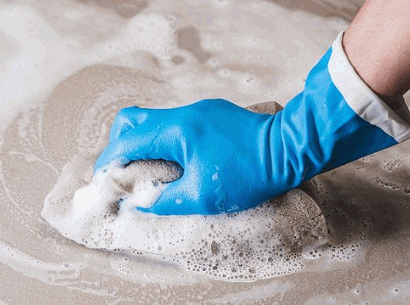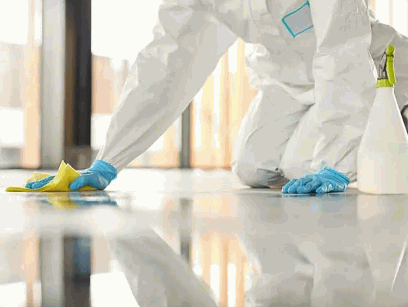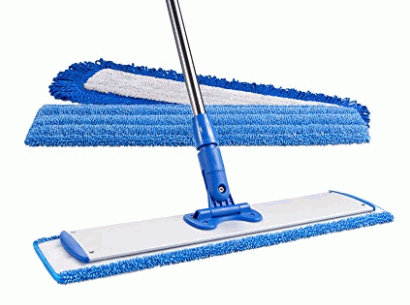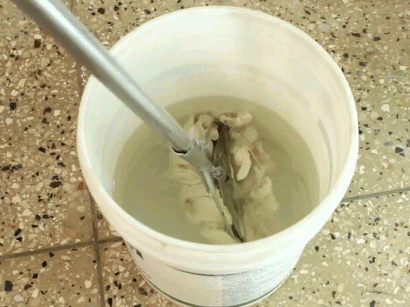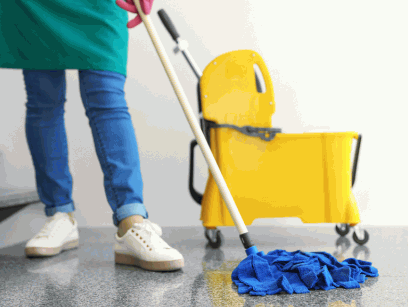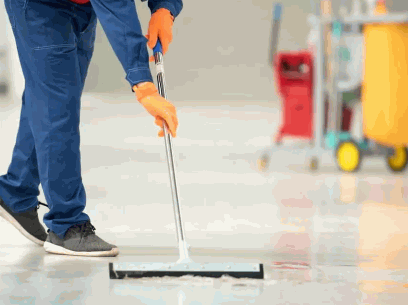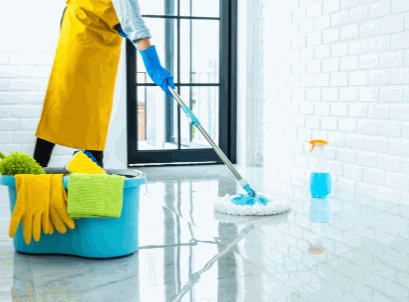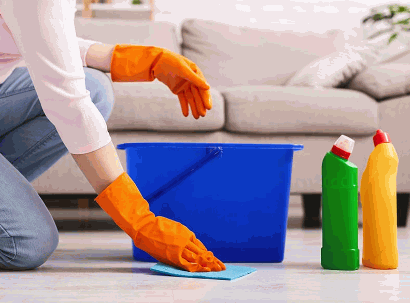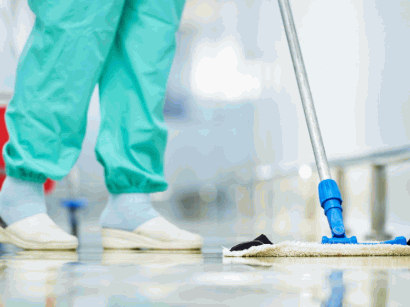Welcome to our guide on how to properly clean and maintain your epoxy flooring. As a homeowner, you want to ensure that your flooring looks visually appealing and is in good condition. However, with daily use and foot traffic, epoxy flooring can become dirty and worn over time. In this article, we will address common concerns and provide helpful tips to help you keep your flooring looking brand new. Are you ready to learn how to effectively clean your epoxy flooring? Let's get started!
What Is Epoxy Flooring?
Epoxy flooring is a resilient and enduring floor coating made by combining a hardener and resin. It delivers a robust, shiny finish that can endure heavy foot traffic and is frequently utilized in industrial and commercial environments.
Delve into: Is Resin Flooring Suitable For Bathrooms
Why Is It Important To Clean Epoxy Flooring?
Regularly cleaning epoxy flooring is crucial in maintaining its durability, appearance, and safety. Dirt buildup can create a slippery surface, making it unsafe to walk on. Moreover, proper cleaning helps retain the glossy finish of epoxy flooring, ensuring it remains visually appealing. By keeping the flooring clean, you can also prolong its lifespan and reduce the need for repairs or replacements.
What Are The Common Tools And Supplies Needed To Clean Epoxy Flooring?
When it comes to maintaining the pristine appearance of your epoxy flooring, having the right tools and supplies is crucial. In this section, we will discuss the common items needed to effectively clean epoxy floors. These include a soft broom or dust mop for removing loose debris and dirt, a mild soap or epoxy-safe cleaner for stubborn stains, a microfiber mop or soft cloth for gentle cleaning, and warm water for diluting cleaning solutions. Let's dive into the details of each essential cleaning tool and supply for epoxy flooring.
1. Soft Broom Or Dust Mop
- First, use a soft broom or dust mop to remove any loose dirt and debris.
- Next, create a cleaning solution by mixing warm water with a mild soap or an epoxy-safe cleaner.
- Then, use a microfiber mop or soft cloth to mop the floor with the prepared solution.
- Rinse the floor with warm water and make sure to dry it thoroughly.
Pro-tip: To keep your epoxy flooring in good condition, regularly sweep or dust mop to prevent scratching from dirt and debris.
2. Mild Soap Or Epoxy-Safe Cleaner
- Check the label for specific instructions on dilution ratios and application methods of the mild soap or epoxy-safe cleaner.
- Test the cleaner on a small, inconspicuous area to ensure compatibility with the epoxy flooring.
- Dilute the cleaner with warm water according to the instructions.
- Apply the cleaning solution using a microfiber mop or soft cloth, working in small sections for thorough cleaning.
- Rinse the floor with warm water to remove any residue from the cleaning solution.
- Dry the floor completely using a clean, dry microfiber mop or cloth.
3. Microfiber Mop Or Soft Cloth
- To maintain the integrity of your epoxy flooring, it is important to use gentle tools such as a microfiber mop or soft cloth for cleaning.
- Dampen the mop or cloth with a mild soap or epoxy-safe cleaner diluted in warm water for effective cleaning.
- Wipe the floor in small sections, regularly rinsing the mop or cloth to prevent spreading dirt and grime.
- After cleaning, make sure the floor is completely dry to avoid water spots or streaks.
Remember to use gentle tools like a microfiber mop or soft cloth when cleaning your epoxy flooring to avoid scratches or dulling the floor's shine. Avoid using abrasive materials that could damage the floor's surface.
4. Warm Water
- Fill a bucket with warm water.
- Add a small amount of mild soap or epoxy-safe cleaner to the warm water.
- Use a microfiber mop or soft cloth to mop the floor with warm water.
- Rinse the floor with clean warm water to remove any soapy residue.
- Dry the floor thoroughly with a clean, dry cloth or allow it to air dry.
What Are The Steps To Clean Epoxy Flooring?
Maintaining the cleanliness of your epoxy flooring is essential for its longevity and appearance. But how exactly do you clean it? In this section, we'll walk through the step-by-step process of cleaning epoxy flooring. From sweeping or vacuuming to mopping and drying, we'll cover all the necessary steps to keep your epoxy floor looking spotless. Get ready to learn the best techniques for maintaining a clean and shiny epoxy floor.
1. Sweep Or Vacuum The Floor
When cleaning epoxy flooring, the first step is crucial. Follow these steps:
- Sweep the floor with a soft broom or vacuum to remove loose debris and dirt.
- Mix mild soap or an epoxy-safe cleaner with warm water to create a cleaning solution.
- Use a microfiber mop or soft cloth to thoroughly mop the floor.
- Rinse the floor with warm water to remove any soap residue.
- Dry the floor completely using a dry mop or cloth.
2. Mix The Cleaning Solution
- Gather supplies: Obtain a bucket, warm water, and an epoxy-safe cleaner or mild soap.
- Measure: Pour the recommended amount of cleaner into the bucket.
- Add water: Fill the bucket with warm water, following the cleaner's dilution instructions.
- Mix: Gently stir the solution until the cleaner is thoroughly mixed with the water.
3. Mop The Floor
- Prepare the cleaning solution by mixing mild soap or epoxy-safe cleaner with warm water.
- Submerge the microfiber mop or soft cloth in the cleaning solution.
- Wring out excess liquid and carefully mop the floor, starting from the farthest corner and working towards the entrance.
- Rinse and wring out the mop or cloth regularly during the mopping process.
- Allow the floor to air dry completely before allowing foot traffic or returning furniture to the area.
4. Rinse The Floor With Warm Water
- After cleaning the epoxy flooring, proceed to rinse the floor with warm water to remove any remaining soap or cleaner residue.
Make sure to change the water frequently to prevent spreading dirt and grime back onto the floor.
5. Dry The Floor
- To effectively dry the floor, first remove all items from it.
- If the floor is wet, use a dry mop or towels to remove any excess moisture.
- To promote air circulation and speed up the drying process, open windows or use fans.
- It is important to avoid walking on the floor until it is completely dry to prevent any smudges or footprints.
How To Remove Stains From Epoxy Flooring?
Epoxy flooring is a durable and low-maintenance option for many commercial and residential spaces. However, like any other type of flooring, it can become stained and dirty over time. In this section, we will discuss the most effective ways to remove different types of stains from epoxy flooring. From oil and grease to food and beverage spills, rust, and even paint or ink stains, we will cover it all. By the end, you'll have the knowledge and tools to keep your epoxy flooring looking as good as new.
1. Oil And Grease Stains
- Blot the stained area with paper towels to soak up any excess oil or grease.
- Apply a dish soap specifically designed to cut through grease directly to the stain and gently scrub with a soft-bristled brush.
- Rinse the area with warm water and thoroughly dry using a clean cloth or towel.
- If the stain persists, create a paste by mixing baking soda with water, apply it to the stain, and let it sit for 5-10 minutes before rinsing and drying.
2. Food And Beverage Stains
- Blot the food or beverage stain immediately with a paper towel or soft cloth.
- Mix mild soap with warm water and gently scrub the stained area.
- Rinse the floor with clean warm water and dry thoroughly.
3. Rust Stains
- Blot the Stain: Use a clean cloth to blot up as much of the rust stain as possible.
- Vinegar Solution: Mix equal parts of white vinegar and water, apply it to the rust stain, and let it sit for a few minutes.
- Scrub the Stain: Gently scrub the affected area with a soft-bristled brush, then rinse with clean water.
- Repeat if Necessary: If the rust stain persists, repeat the process or use a commercial rust remover approved for epoxy floors.
To prevent rust stains, place protective mats under metal furniture and wipe up any water or liquid spills promptly.
4. Paint Or Ink Stains
- Blot the stain with a paper towel to absorb any excess paint or ink.
- Mix warm water with mild soap to create a gentle cleaning solution.
- Apply the solution to the stained area and gently scrub with a soft-bristled brush.
- Rinse the area with clean water and dry thoroughly with a soft cloth.
How To Prevent Damage To Epoxy Flooring?
As durable and low-maintenance as epoxy flooring may be, it is not entirely impervious to damage. To ensure its longevity and keep it looking pristine, it is important to take preventive measures. In this section, we will discuss some simple yet effective ways to protect your epoxy flooring from potential damage. From using mats or rugs to avoiding harsh chemicals, we'll cover all the necessary steps to maintain the quality of your epoxy flooring.
1. Use Mats Or Rugs
- Place mats or rugs at entry points to trap dirt and prevent scratches.
- Use non-slip rugs in wet areas to avoid slips and protect the floor.
- Clean or replace mats regularly to prevent debris accumulation.
Pro-tip: Invest in high-quality, durable rugs or mats designed specifically for use on epoxy flooring to ensure maximum protection and longevity.
2. Avoid Harsh Chemicals
- It is important to avoid using strong acids or alkalis as they can degrade the epoxy flooring.
- Instead, opt for gentle cleaning agents such as mild soap or cleaners specifically formulated for epoxy floors.
- Be sure to read product labels carefully to ensure that the cleaning solution is safe for use on epoxy surfaces.
- To maintain the integrity of the epoxy coating, consider using pH-neutral cleaners.
Protect the luster and longevity of your epoxy flooring by choosing cleaning products that are gentle and safe for the surface.
3. Clean Up Spills Immediately
- Act promptly: Wipe spills with a clean cloth or paper towel to prevent staining and maintain the epoxy floor's pristine appearance.
- Use mild soap: Mix warm water with mild soap or an epoxy-safe cleaner to clean up spills immediately and maintain the cleanliness of the area.
- Dry thoroughly: Once cleaned, make sure to dry the area completely to avoid any potential damage to the epoxy flooring.
Did you know? Epoxy flooring is highly resistant to chemicals, making it the perfect choice for industrial and commercial spaces.
